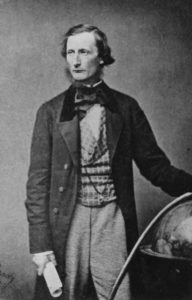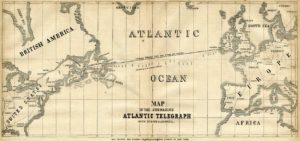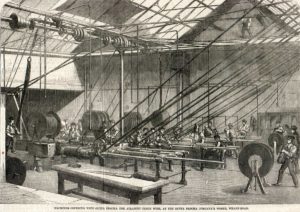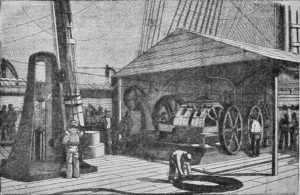The early history of the telegraph in commercial service can largely be told as a series of anecdotes, publicity coups that served to convince people that this was a technology worth embracing. The first of these occurred just a few days after the Washington-to-Baltimore line’s inauguration. On May 18, 1844, this first American telegraph service brought to the capital the shocking news that, after nine ballots’ worth of wrangling over the issue, the Baltimore-based Democratic National Convention had settled on a dark-horse candidate for president by the name of James K. Polk; word of this game changer reached the ears of the Washington political establishment within five minutes of the deciding votes being cast. Clearly the telegraph had its uses, in politics as in so many other facets of life. The newspapers were soon filled with more personal anecdotes about the new technology, such as reports of births and deaths delivered instantaneously to the family members affected.
Nevertheless, Samuel Morse found Congress to be stubbornly unforthcoming with more money to build more telegraph lines. After lobbying fruitlessly over the balance of 1844 for what struck him as the next logical step, an extension of the existing line from Baltimore to New York City, he gave up and turned to the private investors who were now beginning to knock at his door. Although neither he nor they could possibly realize it at the time, it would prove a fateful change of course whose aftereffects can still be felt in the world of today. Unlike the European nations, whose communications networks would be funded and managed by their governments, the United States would rely mostly on private industry. The two contrasting funding and governance models more or less persist to the present day.
Rather than attempting to raise capital and wire the United States all by himself, Morse was content to license his telegraph patent to various regional players. The first of these private telegraph lines, linking Philadelphia to New York City, opened in January of 1846. The telegraph’s spread thereafter was breathtaking; the stampede to get onto the World Wide Web during the 1990s has nothing on the speed with which the telegraph became a fixture of everyday American life during the second half of the 1840s.
By 1851, one could send telegraph messages to and from almost any decent-sized American town east of the Mississippi River. To the average mid-nineteenth-century American, the telegraph seemed literally to be a form of magic. Newspapers published rapturous poetry dedicated to Morse’s wondrous invention, which had “annihilated time and space.” Thanks to the telegraph, the United States as a whole became infatuated with the wonders of technology — an infatuation that has never really left it. A thoroughly impressed British visitor reported on the extraordinary range of uses to which the telegraph was already being put just five years after the first lines opened for business:
It is employed in transmitting messages to and from bankers, merchants, members of Congress, officers of government, brokers, and police officers. [It is used for] items of news, election returns, announcements of deaths, inquiries respecting the health of families and individuals, daily proceedings of the Senate and the House of Representatives, orders of goods, inquiries respecting the sailing of vessels, proceedings of cases in various courts, summoning of witnesses, messages for express trains, invitations, the receipt of money at one station and its payment at another; for persons requesting the transmission of funds from debtors, consultation of physicians, and messages of every character usually sent by the mail. The confidence in the efficiency of telegraphic communication is so complete that the most important commercial transactions daily transpire by its means between correspondents several hundred miles apart.
The financiers who built this network out from nothing in almost no time at all were more often than not connected with the railroads that were busily binding the sprawling nation together in another way. Indeed, the telegraph and the railroad were destined to be boon companions for a long, long time to come; the two usually ran along the same rights-of-way, just as with that very first telegraph line from Washington, D.C., to Baltimore. Together they were the necessary prerequisites of a burgeoning new age of big business; they became the handmaids of the modern bureaucratic corporation, with its tendrils stretching across the country like the arms of an octopus (a rather sinister analogy that would become a populist favorite during the Gilded Age to come).
In the meanwhile, Western Europe was being wired together at a slower pace. The telegraph first captured anecdotal headlines in Britain on August 6, 1844, when it was used to send word from Windsor Palace to Fleet Street that Prince Alfred, Queen Victoria’s second son, had been born. The Duke of Wellington forgot to bring his best suit down from London with him for the celebratory banquet, but the telegraph and the railroad, those two fast stablemates of Progress, saved the day: an urgent electronic message was sent back up the line, and the duke’s ensemble arrived on the next train.
On January 3, 1845, the railroad and the telegraph had starring roles in a sensational murder case, when one John Tawell killed his mistress in Slough and jumped on a train for London. The police in Slough sent a telegraph message to their counterparts in London to watch for him at the station, and the blackguard was apprehended as he climbed down from his carriage. “It may be observed,” wrote the London Times, “that had it not been for the efficient aid of the London telegraph, the greatest difficulty as well as delay would have occurred in the apprehension of the party now in custody.” After the murderer was duly executed, the telegraph was immortalized in verse as “the cords that hung John Tawell.”
Observing the more rapid expansion of the telegraph in the United States, Britain and the other European nations grudgingly came to accept that Samuel Morse’s simple, robust system was more practical than any of their more baroque approaches. And so, gradually, the rudimentary tool that was the Morse key and the more refined one that was the Morse Code became an international standard. Morse himself, who was determined to receive every dollar and every bit of credit he felt he had coming to him for his inventions, was less pleased than he might have been by these developments, in that he usually wasn’t paid for Europe’s copycat systems. (In 1860, France and several other European nations would finally agree to pay him a one-time joint indemnity of $80,000, far less than he believed he was owed.)
Of course, Morse’s original telegraph had to evolve in some ways in order for a single 40-mile wire to be transformed into a dense network of connections binding entire nations together. Although the core components of Morse’s telegraph — a Morse key used to transmit Morse Code — would remain the same for a century and more, everything else was ripe for improvement. Better batteries and better cables stretched the possible distance between stations and repeaters almost exponentially year by year; switchboards, timetables, and manual routing protocols were developed to move messages through the system quickly and efficiently from any given source to any given destination.
The new telegraph companies attracted the sort of brainy young men who, had they been born in the following century, might have become computer hackers. A freewheeling culture of competitive cooperation that wasn’t at all far removed from the future hacker culture developed around the telegraph, as all of these bright sparks relentlessly optimized their systems, creating their own legends and lore, heroes and villains in the process. They developed shortcuts for talking with one another along the wires that smack of nothing so much as Internet chat: “SFD” stood for “stop for dinner,” “GM” for “good morning”; one almost expects to find an “LOL” lurking around in there somewhere. During downtime, they filled the lines with such idle chatter, or played checkers and chess with their counterparts in other cities using a special system of codes they’d developed — the original form of networked gaming. And surely they must have made fun of the clueless suits who believed they were the ones running things…
As the second half of the nineteenth century began, then, the telegraph had already become an inexorable transformative force on two continents. There now remained only the most world-transforming feat of connectivity of them all: to bridge the aforementioned two continents themselves, thereby to turn two discrete communications networks into one.
Over the last 50 years, the arrival of steamships on the scene had reduced the time it took to get news across the Atlantic from four or six weeks to as little as ten days under ideal conditions. Yet in the new age of the telegraph such an interval still seemed painfully long. What was needed was obvious: a telegraph wire running across — or rather under — the Atlantic Ocean. Samuel Morse had envisioned just such a thing already in 1843: “A telegraph communication on my plan may with certainty be established across the Atlantic! Startling as this may seem now, the time will come when this project is realized.” Nine years later, the magazine Scientific American dreamed of a future when “the earth will be belted by the electric wire, and New York will yet be able to send the throb of her electric pulse through our whole continent, Asia, Africa, and Europe in a second of time.” Such aspirations seemed far-fetched even in light of the magical powers of current telegraph systems. And yet one thoroughly remarkable man would soon set in motion a major transatlantic effort to realize them — an effort whose vision, daring, and sheer audacity makes it worthy of comparison to the twentieth century’s Project Apollo.
This giant nerve, at whose command
The world’s great pulses throb or sleep —
It threads the undiscerned repose
Of the dark bases of the deep.Around it settle in the calm
Fine tissues that a breath might mar,
Nor dream what fiery tidings pass,
What messages of storm and war.Far over it, where filtered gleams
Faintly illumine the mid-sea day,
Strange, pallid forms of fish or weed
In the obscure tide softly sway.And higher, where the vagrant waves
Frequent the white, indifferent sun,
Where ride the smoke-blue hordes of rain
And the long vapors lift and run,Pauses, perhaps, some lonely ship
With exile hearts that homeward ache —
While far beneath it flashed a word
That soon shall bid them bleed or break.— “The Atlantic Cable” by Charles G.D. Roberts
During this antebellum era of the United States, New York City’s Astor House was the most famous hotel in the country, the place where all of the movers and shakers stayed when they came to the business capital of the nation. In January of 1854, two of the Astor’s guests happened to be Matthew Field, a prominent railroad engineer, and Frederick Gisborne, a British entrepreneur who was attempting to secure additional funding for a project that had proved much more difficult than he had first anticipated: a telegraph line linking the town of St. John’s on the island of Newfoundland with the town of Sydney on the island of Cape Breton, which entailed some 400 miles of overland and about 85 miles of undersea cable.
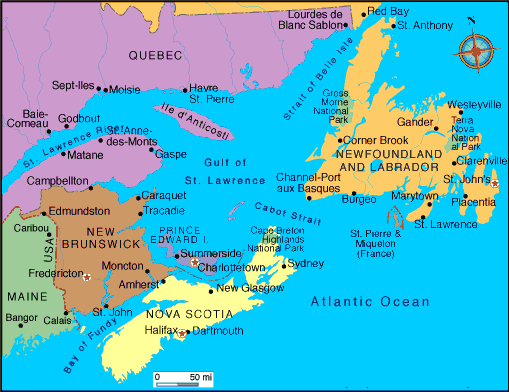
The undersea portion of the telegraph line would need to be run between Channel-Port aux Basques and the northern tip of Cape Breton, where Cape Breton Highlands National Park is today.
When they bumped into one another one evening in the bar and Gisborne told Field how strapped for cash he was, his interlocutor could well understand the reluctance of potential investors. He asked Gisborne why on earth he wanted to build a telegraph cable in such a remote and inhospitable location at all, serving a Newfoundland population of fishermen that numbered in the bare handful of thousands. Gisborne’s response surprised him: he explained that St. John’s was actually the most easterly town in the Americas, fully one-third closer to Europe than New York City was. If fast steamers carrying urgent messages docked there instead of at one of the larger eastern cities, then passed said messages on to a telegraph operator there, they could substantially cut the communication time between the two continents. Gisborne envisioned a bustling trade of businesses and governments willing to pay well to reduce their best-case communication lag from ten to seven days.
Matthew Field was intrigued enough that he mentioned Gisborne and his scheme to his brother Cyrus Field, who at the age of just 33 was already one of the richest men in New York City. He had made his fortune in paper, but was now semi-retired from business life; being possessed of a decided taste for adventure, he had recently returned from an expedition to some of the more remote regions of South America, in the company of the great landscape painter Frederic Church. Cyrus Field took a meeting with Gisborne, but wasn’t overly impressed with his plan, which struck him as an awful lot of trouble and expense for a fairly modest gain in communication speed. The matter might have ended there — but for one thing. “After [Gisborne] left,” wrote Henry M. Field (another of Cyrus’s brothers) in his history of the Atlantic Cable, “Mr. Field took the globe which was standing in the library, and began to turn it over. It was while thus studying the globe that the idea first occurred to him that the telegraph might be carried further still, and be made to span the Atlantic Ocean.”
It’s hard not to compare this realization with Samuel Morse’s own eureka moment aboard the Sully 22 years earlier. Like Morse at the time, Field was enough of a rank amateur to believe that his brainstorm was a new idea under the sun. Knowing nothing whatsoever about telegraphy, eager to find out if a transatlantic cable was a realistic possibility, Field dispatched two letters. One was to Morse, the one name in the field that absolutely everyone was familiar with. The other was to one Matthew Fontaine Maury, a noted oceanographer and intellectual jack-of-all-trades who wore the uniform of the United States Navy. Both responded enthusiastically: Morse was excited enough to join the project as an official advisor and to offer Field the use of his precious telegraph patent for free, while Maury explained that he had thought about the question enough already to propose a route for the cable between Newfoundland and Ireland, based upon deep-sea soundings he had recently conducted. The route in question was, he said, “neither too deep nor too shallow; yet it is so deep that the wires but once landed will remain forever beyond the reach of vessels’ anchors, icebergs, and drifts of any kind, and so shallow that the wires may be readily lodged upon the bottom.”
Field’s further inquiries revealed that underwater telegraphy wasn’t an entirely black art. As early as 1845, well before the landlocked telegraph became a reality of daily life in the developed world, an experimental cable had been laid under the Hudson River between New York City and Fort Lee, New Jersey, sheathed in a rubber-packed lead pipe; it had functioned for several months, until the winter ice did it in. In 1851, an underwater cable had bridged the 31 miles of the English Channel, to be followed soon after by another cable connecting Britain to Ireland. Using the latest batteries and wiring, such distances and more were by now possible without employing any repeaters.
So, Field set about enlisting other wealthy men into his cause, whilst getting Gisborne to accept a relegation to the role of chief engineer in what was now to be a much more ambitious venture than he had ever envisioned. In March of 1854, a company was founded with an appropriately ambitious name: the New York, Newfoundland, and London Telegraph Company. The founders estimated that they would need about $1.5 million to complete their task. This was no small sum in 1854; the entire budget of the federal government of the United States that year totaled just $54 million. Nevertheless, the project would end up costing far, far more. “God knows that none of us were aware of what we had undertaken to accomplish,” Cyrus Field would muse later. Had they known, it is doubtful they ever would have begun.
There is nothing in the world easier than to build a line of railroad or of telegraph on paper. You have only to take the map and mark the points to be connected, and then with a single sweep of the pencil to draw the line along which the iron track is to run. In this airy flight of the imagination, distances are nothing. All obstacles disappear. The valleys are exalted, and the hills are made low, soaring arches span the mountain streams, and the chasms are leaped in safety by the fire-drawn cars.
Very different it is to construct a line of railroad or of telegraph in reality; to come with an army of laborers, with axes on their shoulders to cut down the forests, and with spades in their hands to cast up the highway. Then poetry sinks to prose, and instead of flying over the space on wings, one must traverse it on foot, slowly and with painful steps. Nature asserts her power, and, as if resentful of the disdain with which man in his pride affected to leap over her, she piles up new barriers in his way. The mountains with their rugged sides cannot be moved out of their place, the rocks must be cleft in twain, to open a passage for the conqueror, before he can begin his triumphal march. The woods thicken into impassable jungle, and the morass sinks deeper, threatening to swallow up the horse and his rider, until the rash projector is startled at his own audacity. Then it becomes a contest of forces between man and nature, in which, if he would be victorious, he must fight his way. The barriers of nature cannot be lightly pushed aside, but must yield at last only to time and toil, and “man’s unconquerable will.”
— Henry M. Field, The Story of the Atlantic Telegraph
The newly incorporated New York, Newfoundland, and London Telegraph Company decided that its first goal ought to be the completion of Gisborne’s original project, which would also constitute the fulfillment of two-thirds of its name: a telegraph line linking Newfoundland to New York City, via Cape Breton. Such a line would hopefully bring some money in to help fund the vastly more audacious final third of the company’s name.
The first stage of this first goal required no underwater cable, but was daunting enough in its own right: it entailed running an overland cable from St. John’s across the widest part of Newfoundland to the point where the underwater cable was planned to begin. Gisborne had managed to complete the first 40 miles of this link before his money ran out; that left 260 miles still to go. Matthew Field took charge of this endeavor in the summer of 1854, anticipating that it would be done within a year. But he hadn’t reckoned with the rugged, isolated, in many places well-nigh unmapped terrain the work party had to cross, where opportunities for living off the land were few. The logistics surrounding the building of the line thus became much more complicated than the construction effort itself; the 600 men involved in the effort had to build their own roads as they went just to get supplies in and out. “Recently, in building half a mile of road, we had to bridge three ravines,” wrote Matthew Field to his brother Cyrus on one occasion. “Why didn’t we go around the ravines? Because Mr. Gisborne had explored twenty miles in both directions and found more ravines. That’s why!” The whole project could have served as a case study in why builders of telegraph lines usually preferred to follow the smooth, straight paths which the builders of railroads had already cut through the landscape. Alas, that wasn’t an option on Newfoundland.
And then the dark, cold northern winter set in, exacerbating the builders’ suffering that much more. “What hardships and suffering the men endured — all this is a chapter in the History of the Telegraph which has not been written, and which can never be fully told,” writes Henry Field. Bridging Newfoundland and then constructing another 100 miles of overland telegraph line on Cape Breton to reach Sydney wound up taking two years and costing more than $1 million all by itself.
While Matthew Field’s party was inching its way through the wilds, Cyrus Field was growing impatient to begin laying the undersea part of the route, which he saw as an important test run of sorts for the eventual laying of an Atlantic-spanning cable. He went to London to purchase 85 miles of the best undersea cable money could buy, the same as that which had been used to connect Britain to France and Ireland. It consisted of three intertwined copper-alloy wires, sheathed in tarred hemp, gutta-percha, and galvanized iron wire — guaranteed, so the sellers said, to be impervious to water forever. Field made plans to lay the undersea cable already in the summer of 1855, when the overland cable was still only half completed.
Having as keen an instinct for publicity as any tech mogul of today, Field decided to turn the laying of the cable into a junket for existing and potential investors. Thus on August 7, 1855, the luxury coastal steamer James Adgar departed New York Harbor with many of the brightest stars in the moneyed East Coast firmament aboard. It was to rendezvous off the coast of Newfoundland with an older sailing ship, a sturdy brig called the Sarah L. Bryant carrying the shiny new cable from London, then tow it as it paid out the cable behind it across the Cabot Strait that separates Newfoundland from Cape Breton.
Right from the start, everything that possibly could went wrong, a result not only of bad luck but of a thoroughgoing lack of planning and preparation. The Bryant failed to turn up at the appointed time. When it did appear several days late, it was in a sorry state, having been badly battered by a rough Atlantic crossing weighted down by the cable in its hold. More days were spent on repairs, after which an impenetrable fog rolled in and forced the two ships to sit idle for yet 48 more hours. When the weather cleared at last and the Adgar tried to take the Bryant in tow to begin the operation, a series of cock-ups caused the steamship to ram the brig broadside, very nearly breaking it in two. The captain of the Adgar, whose name was Turner, was by now convinced — and not without justification, it must be admitted — that he was dealing with a bunch of rank amateurs; he grew willfully uncooperative, refusing to steer the course and speed asked of him even after he finally had the Bryant in tow. Cyrus Field and his party watched with alarm as the Adgar‘s high speed, combined with the weight of the cable spooling out behind, caused the Bryant‘s stern to dip lower and lower into the water. Meanwhile the light breeze that had marked the morning’s weather was becoming a howling sidelong gale by mid-afternoon, threatening to capsize the already floundering brig. The captain of the Bryant felt he had no choice: he cut both the tow rope and the telegraph cable, letting the latter fall uselessly into the ocean.
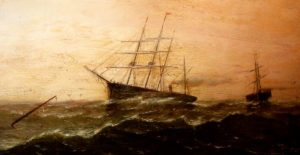
John Wells Stancliff, an amateur painter who was a part of the 1855 attempt to lay a telegraph cable from Newfoundland to Nova Scotia, created this dramatic image of the Sarah L. Bryant being towed through dangerously choppy seas by the James Adgar.
The company’s first attempt to lay an undersea cable had proved an unadulterated fiasco, with the chattering class in ringside seats for the whole sorry spectacle. The final price tag: $351,000 almost literally tossed into the ocean.
Publicly, the partners blamed it all, more than a little disingenuously, on Captain Turner of the Adgar: “We had spent so much money, and lost so much time, that it was very vexatious to have our enterprise defeated by the stupidity and obstinacy of one man.” In truth, though, the obstinate captain was neither the only nor the most important reason that everything had gone sideways. The company had learned the hard way that a sailing ship in tow simply didn’t have the maneuverability necessary to lay a cable in the notoriously temperamental waters of the North Atlantic.
Luckily, Cyrus Field was a man capable of learning from his mistakes. He traveled to London again and bought another cable. And the next summer, just as the overland lines across Newfoundland and Cape Breton were being completed, he tried again to lay it under the ocean. This time, however, he used the agile modern steamer Propontis for the purpose, and invited no one to witness the endeavor, in case it all went wrong again. He needn’t have worried: it all went off without a hitch. The newly minted telegraph connection between St. John’s and Sydney would suffer no service interruptions for the next ten years — a very impressive service record for any line by the standards of the mid-nineteenth century.
Unfortunately, the completion of Frederick Gisborne’s original project had cost the company all of its starting capital and then some — and yet there were still 2000 miles to go if the cable was to reach Ireland. The completed stretch of line ended up bringing in the merest pittance, as Field had suspected it would when Gisborne first broached his idea to him.
So, Field traveled yet again to London, the financial capital of the world, to beat the bushes for more investors. He met with no less skepticism there than he had in his home country; no less august a personage than the head of the Royal Greenwich Observatory called it “a mathematical impossibility to submerge the cable at so great a depth, and if it were possible, no signals could be transmitted through so great a length.” But Cyrus Field could be persuasive: by the time he left Britain six months later, he had formed a new corporation called the Atlantic Telegraph Company, with £350,000 (the equivalent of £40 million or $53 million today) of investment capital; the roll call of those who had pledged their money to the cause included such well-known names as the novelist William Makepeace Thackeray. Lest anyone accuse him of failing to put his money where his mouth was, know that the total also included the majority of Field’s own remaining fortune.
Almost as importantly, the British government promised to pay £14,000 per year to use the telegraph for diplomatic dispatches, and offered to loan the company the recently commissioned 3500-ton steam-powered battleship HMS Agamemnon for the laying of the cable — a poetically appropriate choice, given how the ship shared a name with the ancient tragedy which contains the first documented description of a long-distance signaling system. So, just like that, the Atlantic Telegraph Company had its first customer. Shortly thereafter, it gained its second, when the American government agreed to virtually the same deal: $70,000 per year to make use of the cable. And the Americans too offered a ship for the purpose of laying it: the USS Niagara, a fast, modern 5200-ton steam-powered frigate that was due to be commissioned in the spring of 1857 in the New York Navy Yard. The pride of the United States Navy already, the Niagara was set to become the biggest and arguably the most powerful warship in service anywhere in the world.
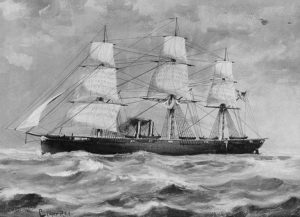
The USS Niagara. It dates from that odd era in naval history when builders were still hedging their bets between sail and steam power by equipping their ships with both. Its hull too was a hybrid of old and new, being made of wood draped over a skeleton of steel.
Working from the proposals of Matthew Fontaine Maury, the company plotted a relatively level course for the cable across the Atlantic seafloor. The company’s engineers believed that, by combining a big power source with a cable big enough to handle all the juice it put out without melting, they could push a signal fully 2000 miles without a single repeater; the old, vexing problem of signal loss down a wire had largely been solved by now by brute force. But another potential problem had since cropped up that rather smacked of this older one.
Earlier underwater telegraph cables had proved to be subject to a peculiar phenomenon: the farther the signal traveled down the wire, the more distorted it became. “A signal which is sent off as a short, sharp, sudden impulse,” writes the historian of telegraphy Silvanus P. Thompson, “in being transmitted to greater and greater distances is changed in character, smoothed out into a longer-lasting impulse, which rises gradually to a maximum and then gradually dies away.” It became harder and harder for the telegraph operator at the other end of the line to work out the dots and dashes of Morse Code from a signal that was slowly being transformed from a stair-step pattern to a series of gentler waves and troughs as it traveled farther and farther down the wire.
This phenomenon, which was dubbed signal “retardation,” was odd in that it didn’t show itself in overland telegraph lines at all. So far, it had been an annoyance rather than a showstopper even for underwater telegraphy — but then, no one had yet tried to lay an underwater cable 2000 miles long. The British physicist Michael Faraday demonstrated retardation to be a direct result of the immersion of an insulated wire into the conductive material that is water; this can cause the insulation to become charged with static electricity, which in turn distorts the signal in the wire it is designed to protect.
A British mathematician and physicist named William Thomson concluded that there was a “law of squares” governing retardation, meaning it was proportional to the square of the cable’s length. But one Wildman Whitehouse, a British surgeon and gentleman experimenter, begged to differ: he claimed that retardation increased linearly down the length of a cable. So, he said, the problem actually wasn’t as big as Thomson made it sound. And there was, he noted, a straightforward solution of sorts to the problem of retardation even when it was at its worst: operators could simply work their Morse keys more slowly to ensure that every pulse remained distinct. In the end, Cyrus Field felt he had no choice but to gamble that he would be able to transmit quickly enough along his line to make a profit.
Field then asked both William Thomson and Wildman Whitehouse what type of cable they thought would work best. Predictably enough, they were in complete disagreement. Thomson believed that the thicker the wire at the core of the cable and the thicker the layer of protective insulation around it, the less retardation the whole would be subject to; he thus recommended a cable as big around as a man’s upper arm. He also believed that a more naturally conductive wire would be subject to less retardation, and therefore proposed a core made of pure copper rather than the more typical copper alloy. Finally, he proposed a new, ultra-sensitive galvanometer for detecting signals on the receiving end, something he had ideas for but had yet to make a reality.
Whitehouse, on the other hand, was vastly more sanguine. A thinner cable made from a copper alloy, combined with the already proven technologies for sending and receiving, would be just fine according to him; his proposed cable would be only as big around as a man’s wrist.
Unsurprisingly, Field opted for Whitehouse’s approach, by far the cheaper and easier of the two to see through in the real world. In fact, his engineers had told him that it was doubtful whether a cable conforming to Thomson’s specifications could be laid at all; it would wind up being simply too heavy to handle.
So, without considering the matter further, Field sent an order to London for 2500 miles of Whitehouse’s cable, at a price of £225,000. (The peaks and valleys of the ocean floor, plus the fact that the cable would not be stretched completely taut, meant that crossing 2000 miles of ocean would surely take considerably more than just 2000 miles of the stuff.) When Thomson was given a snippet of it to test, he was horrified to discover its alloy core was so sloppily made that some sections were twice as conductive as other sections. But the die was now cast.
Whitehouse’s cable may have been comparatively light, but it still weighed one ton per mile, and there was no ship in the world at the time capable of carrying a load of 2500 tons. Therefore the company made plans to load half of this longest length of cable ever made aboard each of the Agamemnon and the Niagara. The ships would sail together, and when the first ship ran out of cable somewhere in the middle of the Atlantic, the other would splice the beginning of its cable onto the end of the first and complete the job.
On April 24, 1857, the Niagara departed New York Harbor on its maiden voyage across the Atlantic, its decks and holds cleared of guns and ammunition to make room for the massive weight of cable that was to be loaded in Britain. Aboard were the Field brothers, Samuel Morse, and a party of engineers and technicians in the employ of one or the other of Cyrus Field’s recently formed telegraph companies; more personnel would be picked up in Britain. Relations between the United States and Britain were not yet as warm as they would become in later decades; the British Army had, after all, sacked and burned Washington, D.C., within the lifetime of most of the politicians there. The Atlantic cable and the cooperative endeavor of laying it were therefore invested with huge symbolic importance by the governments of both nations. Windy speeches and toasts accompanied the Niagara as it met up with the Agamemnon in Plymouth, England, then continued apace as the two ships loaded their unique cargoes, a tricky process that wound up taking quite some weeks. When that task was completed at last, they sailed on to the tiny port of Queenstown (now known as Cobh) on the southern tip of Ireland, where the eastern end of the cable was to make landfall. As a further symbol of the emerging spirit of transatlantic cooperation and trust, the American Niagara was to begin the laying of the cable on the British side of the ocean, while the British Agamemnon would complete it on the American side.
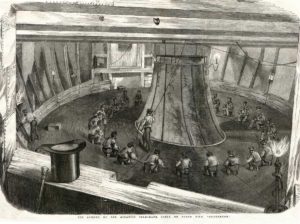
Loading the cable aboard the ships was no small task in itself. It had to be dragged up from the quay and laboriously wound around the giant spools in the ships’ holds.
But first, the two ships anchored side by side off the coast of Ireland to conduct an important test. The crew of the Niagara ferried the end of their cable over to the Agamemnon, where it was spliced with the one onboard that ship. Telegraph operators aboard each of the ships then sent a series of test signals back and forth. The 2500-mile connection worked. Whatever the ultimate merits of the cable Field had elected to purchase, the moment was a telling testament to an extraordinarily rapid evolution in electrical engineering and materials science since that time less than two decades before when Samuel Morse had struggled to push a decipherable signal down 40 feet of wire.
With the test completed, it was time to begin the actual laying of the cable. Its end came ashore on the evening of August 5, 1857, to the accompaniment of much celebration and speechifying. Cyrus Field was clearly touched when he stepped up to the podium:
I have no words to express the feelings which fill my heart tonight — it beats with love and affection for every man, woman, and child who hears me. I may say, however, that, if ever at the other side of the waters now before us, any one of you shall present himself at my door and say that he took hand or part, even by an approving smile, in our work here today, he shall have a true American welcome. I cannot bind myself to more, and shall merely say, “What God has joined together, let not man put asunder.”
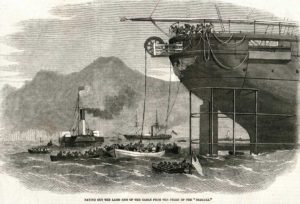
Paying out the first of the cable from the stern of the Niagara. Note the cage around the ship’s screws, put there to make sure the cable couldn’t become entangled in them. The sailors liked to call it a “crinoline,” after the wire hoops used to support ladies’ skirts.
A 25-year-old British telegraph engineer named Charles Bright had designed an ingenious mechanism for drawing the cable up from the spools in the ships’ holds and paying it out in a controlled fashion behind them. As the Niagara and its escort crept away from Ireland at a speed of three to six knots, Bright himself monitored his machine day and night, adjusting it constantly to account for the shifting topography of the seafloor beneath and the wind and waves that buffeted the vessel on whose deck it rode. Telegraph operators ashore in Ireland and aboard the ship tapped out a constant patter back and forth to confirm that the cable was still functioning. The distinctive, steady rumble of the pay-out mechanism became an equally important source of comfort to everyone aboard, another reminder that everything was working as it ought to. “If one should drop to sleep, and wake up at night,” wrote Henry Field later, “he has only to hear the sound of ‘the old coffee mill,’ and his fears are relieved, and he goes to sleep again.”
By the dawn hours of August 10, almost 300 miles of cable had been laid without a hitch, and Bright stepped away from his machine for some much needed rest, leaving it in the charge of one of his assistants. At 3:45 AM, the ship plunged into the trough of an unusually large wave. As it rose again, the cable was pulled taut. The attendant Bright had left in charge should have reduced the braking force in the mechanism, to let the cable spool out faster and ease the strain on it. But he failed to do so in time. The cable snapped with a sound that reverberated through the decks like the clap of doom. In a flash, the frayed end was lost forever beneath the ocean.
“Instantly ran through the ship a cry of grief and dismay,” writes Henry Field. “All gathered on deck with feelings which may be imagined.” The captain of the Niagara would remember the moment as akin to the death of a “dear friend”; he promptly ordered his ship’s flag lowered to half mast.
Field and his colleagues did a quick assessment, and concluded that the well over 300 miles of cable they had lost left them without enough of it remaining to start over again and hope to complete their task. There was nothing for it but to return to Britain. Once back in London, Field learned that it wasn’t possible to manufacture the needed additional cable before the Atlantic winter made the project of laying it too dangerous to attempt. So, the Niagara sailed for home for the season, and the naysayers and mockers on both sides of the ocean came out in force. A parody of “Pop Goes the Weasel!” made the music-hall rounds:
Pay it out! Oh, pay it out
As long as you are able:
For if you put the damned brake on:
Pop goes the cable!
But Cyrus Field professed himself to be undaunted — indeed, to be more encouraged than discouraged by recent events. Rather than the dismal failure described in the popular press, he chose to see his first attempt to lay his Atlantic Cable as a successful proof of concept; he had sent and received underwater telegraph signals over a gap several times longer than anyone had ever managed before. All he needed to go the full distance were a modestly redesigned paying-out mechanism and some equally modest operational refinements. He said as much in a letter to his investors:
The successful laying down of the Atlantic Telegraph Cable is put off for a short time, but its final triumph has been fully proved by the experience that we have had. My confidence was never so strong as at the present time, and I feel sure that, with God’s blessing, we shall connect Europe and America with the electric cord.
The first Atlantic cable may have been lost forever beneath the cold, dark waves of the ocean, but Field’s passion for the task burned as warmly as ever.
(Sources: the books The Victorian Internet by Tom Standage, Power Struggles: Scientific Authority and the Creation of Practical Electricity Before Edison by Michael B. Schiffer, Lightning Man: The Accursed Life of Samuel F.B. Morse by Kenneth Silverman, A Thread across the Ocean: The Heroic Story of the Transatlantic Telegraph by John Steele Gordon, The Story of the Atlantic Telegraph by Henry M. Field, and The Life of William Thomson by Silvanus Phillips Thompson; The Atlantic Monthly of November 1862. Online sources include “The Telegraph and Chess” by Bill Wall, Distant Writing: A History of the Telegraph Companies in Britain between 1838 and 1868 by Steven Roberts, and History of the Atlantic Cable & Undersea Communications.)
